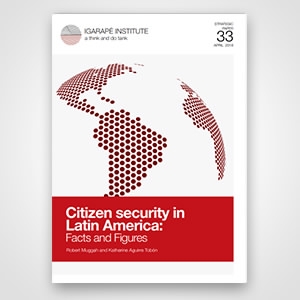
World
13:55, 28-Apr-2018
Report turns spotlight on 'world's most homicidal region'
By Bertram Niles

Since 2000, a staggering 2.5 million people have been officially recorded as having been murdered in Latin America, says a new report which lays bare the horrendous homicide rates in the region.
And, what's more, that figure is likely an undercount given high levels of disappearances and low clearance rates of criminal violence, says the report by the Igarape Institute, a Brazil-based think tank focused on security and development issues.
Latin America – South America, Central America and the Caribbean – has the highest homicide rates in the world. Igarape says the region has just 8 percent of the world's population, but a third of its murders. The homicide rate is 21.5 per 100,000, as compared to a global murder rate of roughly 7 per 100,000.
Last year alone, about 154,000 people were intentionally murdered.
"Many Latin American countries, states and cities are facing a chronic public security crisis," the report says. "In spite of more than a decade of modest economic growth, crime and victimization rates are rising, not dropping."
At least 17 of the top 20 most homicidal countries in the world are located in Latin America. Four nations – Brazil, Colombia, Mexico and Venezuela – account for a quarter of all the murders globally and, interestingly, they all have presidential elections this year. When it comes to murders per capita, the top four countries are El Salvador, Jamaica, Venezuela and Honduras.

67 percent of the murders in Latin America are gun-related, twice the global average. /VCG Photo
67 percent of the murders in Latin America are gun-related, twice the global average. /VCG Photo
Not all of the region suffers from such "epidemic levels" of bloody violence, however.
“Latin America is a large area and there are lots of variations," Robert Muggah, Igarape's research director and the report's co-author, was quoted as saying. “The overall trend right now is one of increasing homicides and deteriorating security. But as a region – including Mexico down to Central America and South America – the rate of homicide is set to continue increasing up until 2030. The only other places we are seeing similar kinds of increases are in parts of southern and central Africa and some war zones.”
Muggah also said that the vast majority of the murders are committed with firearms. About two-thirds percent are gun-related while the global average is 32 percent.
Not unsurprisingly, the toll is greatest among the young. Half of the victims are between 15-29 years old, representing a tremendous human cost and considerable lost productivity, the report says.
Cartel and gang-related violence is listed a significant contributor to the high violence rates which are also linked to high rates of urbanization.
According to the report, many countries do not have enough police officers in high-crime areas. In any case, public trust in the police is quite low with almost half of Latin Americans believing that lawmen are involved in crime.

All this led the authors of the report to say that "there are few more urgent priorities than restoring and strengthening the security and safety of citizens across the region."
But how?
Since at least the 1970s and 1980s, the report notes, the conventional approach to fighting crime consisted of repressive police deployments, tougher penalties on offenders and the construction of more prisons backed by overwhelming public support.
"Yet in spite of years of efforts and broad social and economic improvements, crime has worsened and prison populations ballooned," it says. "In recent years, some governments elected to double down on so-called 'mano dura' (iron fist) approaches."
Others, however, have taken alternative routes since the late 1990s, focusing on what's termed “citizen security” programs, which include reforms to policing strategies, criminal justice procedures, employment schemes for high-risk groups, alternatives to incarceration, violence prevention measures, strategic management and data collection/analysis improvements.

The Igarape report's cover
The Igarape report's cover
But the report says too few of these programs have been properly evaluated.
And with the presidential election season approaching in Brazil, Colombia, Mexico and Venezuela, several contenders have been upping the ante on crime, with one in Mexico going as far as recommending chopping off thieves’ hands.
But Muggah cautions against a heavy-handed approach. “There is a risk right now that Latin Americans are seduced by this narrative of mano dura," he told The Guardian. "[But] we will not solve this problem by simply throwing more police, longer sentences and more prisons at it.”

SITEMAP
Copyright © 2018 CGTN. Beijing ICP prepared NO.16065310-3
Copyright © 2018 CGTN. Beijing ICP prepared NO.16065310-3